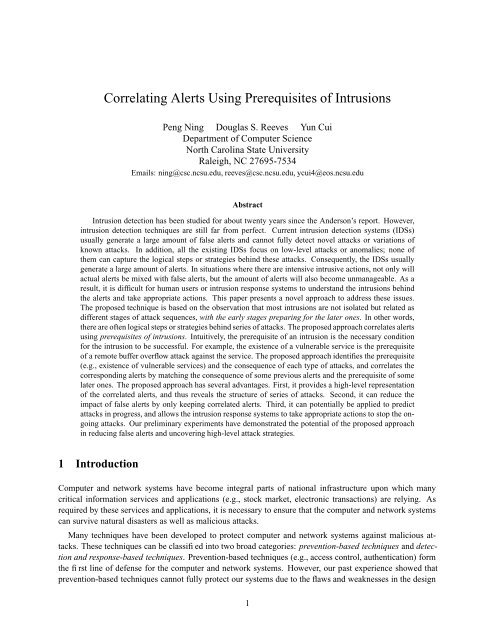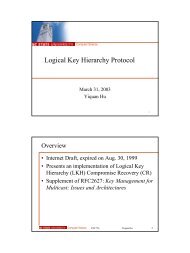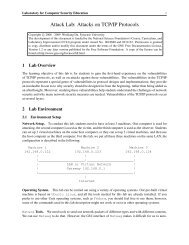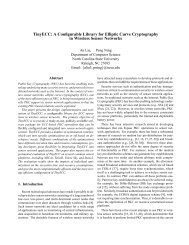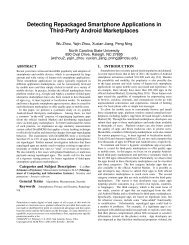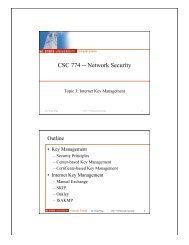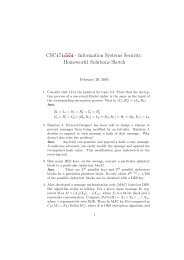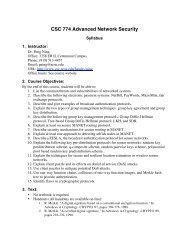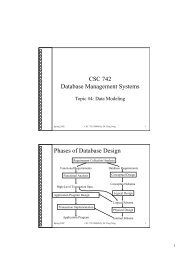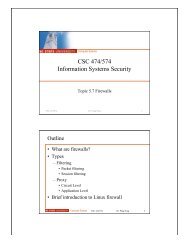Correlating Alerts Using Prerequisites of Intrusions - Dr. Peng Ning ...
Correlating Alerts Using Prerequisites of Intrusions - Dr. Peng Ning ...
Correlating Alerts Using Prerequisites of Intrusions - Dr. Peng Ning ...
Create successful ePaper yourself
Turn your PDF publications into a flip-book with our unique Google optimized e-Paper software.
<strong>Correlating</strong> <strong>Alerts</strong> <strong>Using</strong> <strong>Prerequisites</strong> <strong>of</strong> <strong>Intrusions</strong><br />
<strong>Peng</strong> <strong>Ning</strong> Douglas S. Reeves Yun Cui<br />
Department <strong>of</strong> Computer Science<br />
North Carolina State University<br />
Raleigh, NC 27695-7534<br />
Emails: ning@csc.ncsu.edu, reeves@csc.ncsu.edu, ycui4@eos.ncsu.edu<br />
Abstract<br />
Intrusion detection has been studied for about twenty years since the Anderson’s report. However,<br />
intrusion detection techniques are still far from perfect. Current intrusion detection systems (IDSs)<br />
usually generate a large amount <strong>of</strong> false alerts and cannot fully detect novel attacks or variations <strong>of</strong><br />
known attacks. In addition, all the existing IDSs focus on low-level attacks or anomalies; none <strong>of</strong><br />
them can capture the logical steps or strategies behind these attacks. Consequently, the IDSs usually<br />
generate a large amount <strong>of</strong> alerts. In situations where there are intensive intrusive actions, not only will<br />
actual alerts be mixed with false alerts, but the amount <strong>of</strong> alerts will also become unmanageable. As a<br />
result, it is difficult for human users or intrusion response systems to understand the intrusions behind<br />
the alerts and take appropriate actions. This paper presents a novel approach to address these issues.<br />
The proposed technique is based on the observation that most intrusions are not isolated but related as<br />
different stages <strong>of</strong> attack sequences, with the early stages preparing for the later ones. In other words,<br />
there are <strong>of</strong>ten logical steps or strategies behind series <strong>of</strong> attacks. The proposed approach correlates alerts<br />
using prerequisites <strong>of</strong> intrusions. Intuitively, the prerequisite <strong>of</strong> an intrusion is the necessary condition<br />
for the intrusion to be successful. For example, the existence <strong>of</strong> a vulnerable service is the prerequisite<br />
<strong>of</strong> a remote buffer overflow attack against the service. The proposed approach identifies the prerequisite<br />
(e.g., existence <strong>of</strong> vulnerable services) and the consequence <strong>of</strong> each type <strong>of</strong> attacks, and correlates the<br />
corresponding alerts by matching the consequence <strong>of</strong> some previous alerts and the prerequisite <strong>of</strong> some<br />
later ones. The proposed approach has several advantages. First, it provides a high-level representation<br />
<strong>of</strong> the correlated alerts, and thus reveals the structure <strong>of</strong> series <strong>of</strong> attacks. Second, it can reduce the<br />
impact <strong>of</strong> false alerts by only keeping correlated alerts. Third, it can potentially be applied to predict<br />
attacks in progress, and allows the intrusion response systems to take appropriate actions to stop the ongoing<br />
attacks. Our preliminary experiments have demonstrated the potential <strong>of</strong> the proposed approach<br />
in reducing false alerts and uncovering high-level attack strategies.<br />
1 Introduction<br />
Computer and network systems have become integral parts <strong>of</strong> national infrastructure upon which many<br />
critical information services and applications (e.g., stock market, electronic transactions) are relying. As<br />
required by these services and applications, it is necessary to ensure that the computer and network systems<br />
can survive natural disasters as well as malicious attacks.<br />
Many techniques have been developed to protect computer and network systems against malicious attacks.<br />
These techniques can be classified into two broad categories: prevention-based techniques and detection<br />
and response-based techniques. Prevention-based techniques (e.g., access control, authentication) form<br />
the first line <strong>of</strong> defense for the computer and network systems. However, our past experience showed that<br />
prevention-based techniques cannot fully protect our systems due to the flaws and weaknesses in the design<br />
1
and development <strong>of</strong> the systems. As a result, the detection and response based techniques (i.e., intrusion<br />
detection and response systems) are used as a second line <strong>of</strong> defense along with the prevention-based ones.<br />
Intrusion detection techniques can be roughly classified as anomaly detection and misuse detection.<br />
Anomaly detection (e.g., NIDES/STAT [10]) is based on the normal behavior <strong>of</strong> a subject (e.g., a user<br />
or a system); any action that significantly deviates from the normal behavior is considered intrusive. Misuse<br />
detection (e.g., NetSTAT [21]) detects intrusions based on the characteristics <strong>of</strong> known attacks or system<br />
vulnerabilities; any action that conforms to the pattern <strong>of</strong> a known attack or vulnerability is considered<br />
intrusive.<br />
Intrusion detection techniques are still far from perfect; current intrusion detection systems (IDSs) cannot<br />
fully detect novel attacks or variations <strong>of</strong> known attacks without generating a large amount <strong>of</strong> false alerts<br />
(i.e., high false alert rate and low detection rate). In addition, all the current IDSs focus on low-level attacks<br />
or anomalies; none <strong>of</strong> them can capture the logical steps or strategies behind these attacks. Consequently,<br />
the IDSs usually generate a large amount <strong>of</strong> alerts, and the alerts are raised independently though there may<br />
be logical connections between them. In situations where there are intensive intrusive actions, not only will<br />
actual alerts be mixed with false alerts, but the amount <strong>of</strong> alerts will also become unmanageable. As a result,<br />
it is difficult for human users or intrusion response systems to understand the intrusion behind the alerts and<br />
take appropriate actions.<br />
An important fact has been ignored by most <strong>of</strong> the current intrusion detection techniques. That is, most<br />
intrusions are not isolated, but related as different stages <strong>of</strong> series <strong>of</strong> attacks, with the early stages preparing<br />
for the later ones. For example, hackers need to understand what vulnerable services a host is running<br />
before they can take advantage <strong>of</strong> these services. Thus, they typically scan for vulnerable services before<br />
they break into the system. As another example, in the Distributed Denial <strong>of</strong> Service (DDOS) attacks, the<br />
attacker has to install the DDOS daemon programs in vulnerable hosts before he can instruct the daemons<br />
to launch an attack against another system. Therefore, in a series <strong>of</strong> attacks, one or more previous attacks<br />
usually prepare for the following attacks, and the success <strong>of</strong> the previous steps affects the success <strong>of</strong> the<br />
following ones. In other words, there are <strong>of</strong>ten logical steps or strategies behind series <strong>of</strong> attacks.<br />
Based on this observation, we propose to correlate alerts using prerequisites <strong>of</strong> intrusions to address<br />
the aforementioned problems. Intuitively, the prerequisite <strong>of</strong> an intrusion is the necessary condition for<br />
the intrusion to be successful. For example, the existence <strong>of</strong> a vulnerable service is the prerequisite <strong>of</strong><br />
a remote buffer overflow attack against the service. We assume that the attackers need to launch some<br />
attacks to prepare for the prerequisites <strong>of</strong> some later attacks. For example, they may perform a UDP port<br />
scan to discover the vulnerable services to be attacked. Our basic idea is to identify the prerequisites (e.g.,<br />
existence <strong>of</strong> vulnerable services) and the consequences (e.g., discovery <strong>of</strong> vulnerable services) <strong>of</strong> each type<br />
<strong>of</strong> attacks and correlate the attacks (alerts) by matching the consequences <strong>of</strong> some previous attacks and the<br />
prerequisites <strong>of</strong> some later ones. (Some types <strong>of</strong> attacks are variations <strong>of</strong> each other, and thus should be<br />
treated as the same type.) For example, if we find a UDP port scan followed by a buffer overflow attack<br />
against one <strong>of</strong> the scanned ports, we can correlate them to be parts <strong>of</strong> the same series <strong>of</strong> attacks.<br />
Our proposed approach has several advantages. First, by providing a high-level representation <strong>of</strong> the<br />
correlated alerts (see section 3.4), our approach reveals the structure <strong>of</strong> a series <strong>of</strong> attacks as well as the<br />
strategy behind them. Second, our approach can potentially reduce the impact caused by false alerts. False<br />
alerts, which do not correspond to any real attacks, tend to be more random than the actual attacks, and<br />
are less likely to be correlated to other alerts. Therefore, we can focus on the potentially actual attacks<br />
by picking out the correlated alerts. Finally, our approach can be potentially extended to predict attacks in<br />
progress. By pr<strong>of</strong>iling the past correlated alerts, we may predict the next move <strong>of</strong> on-going attacks and take<br />
appropriate actions to prevent it from happening. As we will show in section 4, our initial experiments have<br />
demonstrated the great potential <strong>of</strong> the proposed approach in reducing false alerts as well as uncovering<br />
2
high-leel attack strategies.<br />
The remainder <strong>of</strong> this paper is organized as follows. The next section discusses the related work on<br />
intrusion detection as well as alert correlation. Section 3 presents our formal framework for correlating alerts<br />
using prerequisites <strong>of</strong> intrusions. Section 4 describes our initial experiments using the proposed approach.<br />
Section 5 discusses several research issues related to the proposed approach. Section 6 concludes this paper<br />
and points out future research directions.<br />
2 Related Work<br />
Intrusion detection has been studied for about twenty years, since Anderson’s report [1]. A survey <strong>of</strong> the<br />
early work on intrusion detection is given in [13], and an excellent overview <strong>of</strong> current intrusion detection<br />
techniques and related issues can be found in a recent book [2].<br />
Intrusion detection techniques can be classified as anomaly detection or misuse detection. Anomaly<br />
detection is based on the normal behavior <strong>of</strong> a subject (e.g., a user or a system); any action that significantly<br />
deviates from the normal behavior is considered intrusive. Misuse detection catches intrusions in terms <strong>of</strong><br />
the characteristics <strong>of</strong> known attacks or system vulnerabilities; any action that conforms to the pattern <strong>of</strong> a<br />
known attack or vulnerability is considered intrusive.<br />
Numerous research as well as commercial IDSs have been developed using anomaly and/or misuse detection<br />
techniques, including host-based IDSs (e.g., USTAT [8]), network based IDSs (e.g., NetSTAT [21],<br />
NFR [16]), and distributed IDSs (e.g., AAFID [18], EMERALD [15]).<br />
All current IDSs are aimed at detecting low-level attacks or anomalies; none can capture the logical steps<br />
or attack strategies behind these attacks. It is usually up to human users to discover the connections between<br />
alerts. However, in intrusion intensive situations, IDSs may generate large numbers <strong>of</strong> alerts, making manual<br />
correlation <strong>of</strong> alerts a very difficult task.<br />
Several alert correlation techniques have been proposed recently to address the aforementioned problem.<br />
In [20], a probabilistic method was used to correlate alerts using similarity between their features. However,<br />
this method depends on parameters selected by human experts (e.g., similarity between classes <strong>of</strong> alerts),<br />
and is not suitable for fully discovering causal relationships between alerts. In [19], a similar approach was<br />
applied to detect stealthy portscans along with several heuristics. Though some such heuristics (e.g., feature<br />
separation heuristics [19]) may be extended to the general alert correlation problem, the approach cannot<br />
fully recover the causal relationships between alerts, either.<br />
Techniques for aggregating and correlating alerts have been proposed by others [6]. In particular, the<br />
correlation method in [6] uses a consequence mechanism to specify what types <strong>of</strong> alerts may follow a given<br />
alert type. This is similar to the specification <strong>of</strong> misuse signatures. However, the consequence mechanism<br />
only uses alert types, the probes that generate the alerts, the severity level, and the time interval between<br />
the two alerts involved in a consequence definition, which do not provide sufficient information to correlate<br />
all possibly related alerts. Moreover, it is not easy to predict how an attacker may arrange a sequence <strong>of</strong><br />
attacks. In other words, developing a sufficient set <strong>of</strong> consequence definitions for alert correlation is not a<br />
solved problem.<br />
Another approach has been proposed to “learn” alert correlation models by applying machine learning<br />
techniques to training data sets embedded with known intrusion scenarios [5]. This approach can automatically<br />
build models for alert correlation; however, it requires training in every deployment, and the resulting<br />
models may overfit the training data, thereby missing attack scenarios not seen in the training data sets.<br />
The alert correlation techniques that we present in this paper address this same problem from a novel angle,<br />
3
overcoming the limitations <strong>of</strong> the above approaches.<br />
3 <strong>Correlating</strong> <strong>Alerts</strong> <strong>Using</strong> <strong>Prerequisites</strong> Of Attacks<br />
3.1 Overview<br />
Our approach is based on the observation that in series <strong>of</strong> attacks, the component attacks are usually not<br />
isolated, but related as different stages <strong>of</strong> the attacks, with the early ones preparing for the later ones. For<br />
example, the attackers <strong>of</strong>ten use certain probing attacks (e.g., IP Sweep, UDP port scan) to identify their<br />
targets before hacking into these systems.<br />
As discussed in the introduction, we propose to correlate the alerts generated by IDSs using prerequisites<br />
<strong>of</strong> the corresponding attacks. Intuitively, the prerequisite <strong>of</strong> an attack is the necessary condition for the<br />
attack to be successful. For example, the existence <strong>of</strong> a vulnerable service is the prerequisite <strong>of</strong> a remote<br />
buffer overflow attack against the service. Moreover, the attacker may make some progress in intruding<br />
the victim system (e.g., discover the vulnerable services, install a Trojan horse program) as a result <strong>of</strong> an<br />
attack. Informally, we call the possible outcome <strong>of</strong> an attack the (possible) consequence <strong>of</strong> the attack. In a<br />
series <strong>of</strong> attacks where the attackers launch earlier attacks to prepare for later ones, there are usually strong<br />
connections between the consequences <strong>of</strong> the earlier attacks and the prerequisites <strong>of</strong> the later ones. Indeed,<br />
if an earlier attack is to prepare for a later attack, the consequence <strong>of</strong> the former attack should at least make<br />
a part <strong>of</strong> the prerequisite <strong>of</strong> the later attack true.<br />
Accordingly, we propose to identify the prerequisites (e.g., existence <strong>of</strong> vulnerable services) and the<br />
consequences (e.g., discovery <strong>of</strong> vulnerable services) <strong>of</strong> each type <strong>of</strong> attacks and correlate alerts, which are<br />
attacks detected by IDSs, by matching the consequences <strong>of</strong> some previous alerts and the prerequisites <strong>of</strong><br />
some later ones. (Some types <strong>of</strong> attacks are variations <strong>of</strong> each other, and thus should be treated as the same<br />
type.) For example, if we find a Sadmind Ping followed by a buffer overflow attack against the corresponding<br />
Sadmind service, we can correlate them to be parts <strong>of</strong> the same series <strong>of</strong> attacks. In other words, we try to<br />
correlate alerts by discovering the causal relationships between them.<br />
In the following subsections, we use a formal approach to develop our alert correlation method.<br />
3.2 Prerequisite and Consequence <strong>of</strong> Attacks<br />
In order to make our approach computable, we propose to use predicates as basic constructs to represent<br />
the prerequisites and (possible) consequences <strong>of</strong> attacks. For example, a scanning attack may discover UDP<br />
services vulnerable to a certain buffer overflow attack. We can use the predicate UDPVulnerableToBOF<br />
(VictimIP, VictimPort) to represent the attacker’s discovery (i.e., the consequence <strong>of</strong> the attack) that the host<br />
having the IP address VictimIP runs a service (e.g., sadmind) at UDP port VictimPort and that the service<br />
is vulnerable to the buffer overflow attack. Similarly, if an attack requires a UDP service vulnerable to the<br />
buffer overflow attack, we can use the same predicate to represent the prerequisite.<br />
Some attacks may require several conditions be satisfied at the same time in order to be successful. To<br />
represent such complex conditions, we use a logical formula, i.e., logical combination <strong>of</strong> predicates, to describe<br />
the prerequisite <strong>of</strong> an attack. For example, a certain network born buffer overflow attack may require<br />
that the target host have a vulnerable UDP service accessible to the attacker through the firewall. This prerequisite<br />
can be represented by UDPVulnerableToBOF (VictimIP, VictimPort) AND UDPAccessibleViaFirewall<br />
(VictimIP, VictimPort). To simplify the discussion, we restrict the logical operations to AND, OR and NOT,<br />
and require that NOT only appear directly before a predicate. For example, we allow logical formula in the<br />
4
form <strong>of</strong> (NOT A (x, y)) OR (NOT B (z)), but not in the form <strong>of</strong> NOT (A (x, y) AND B (z)), though they are<br />
logically equivalent.<br />
We use a set <strong>of</strong> logical formulas to represent the (possible) consequence <strong>of</strong> an attack. For example, an<br />
attack may result in compromise <strong>of</strong> the root privilege as well as modification <strong>of</strong> the .rhost file. Thus, we<br />
may use the following set <strong>of</strong> logical formulas to represent the corresponding consequence: {GainRootAccess<br />
(VictimIP), rhostModified (VictimIP)}. This example says that as a result <strong>of</strong> the attack, the attacker may gain<br />
root access to the system and the .rhost file may be modified. Note that the set <strong>of</strong> logical formulas used to<br />
represent the consequence is essentially the conjunction <strong>of</strong> the formulas and can be represented by a single<br />
logical formula. However, allowing a set <strong>of</strong> logical formulas gives us the convenience and flexibility to<br />
avoid long formulas in consequences.<br />
The consequence <strong>of</strong> an attack is indeed the possible result <strong>of</strong> the attack. In other words, the attack may or<br />
may not generate the stated consequence. For example, after an attacker launches a buffer overflow attack<br />
against a service, he may or may not gain the root access, depending on whether the service is vulnerable to<br />
the attack or not.<br />
We propose to use possible consequence instead <strong>of</strong> actual consequence due to the following two reasons.<br />
First, an IDS may not have enough information to decide whether an attack is effective or not. For example,<br />
a network based IDS can detect certain buffer overflow attacks by matching the patterns <strong>of</strong> the attacks;<br />
however, it cannot decide whether the attempts succeed or not without some specific information from the<br />
related hosts. Thus, it may not be feasible to correlate alerts using the actual consequence <strong>of</strong> attacks. In<br />
contrast, the possible consequence <strong>of</strong> a type <strong>of</strong> attack can be analyzed and made available for IDS. Second,<br />
even if an attack fails to prepare for the follow-up attacks, the follow-up attacks may still occur simply<br />
because, for example, the attacker wants to test the successfulness <strong>of</strong> the previous attack or the attacker<br />
uses a script to launch a series <strong>of</strong> attacks. Thus, using possible consequences <strong>of</strong> attacks will lead to better<br />
opportunity to correlate such attacks.<br />
For the sake <strong>of</strong> brevity, we refer to possible consequence simply as consequence throughout this paper.<br />
3.3 Hyper-alert Type and Hyper-alert<br />
Having predicate as the basic construct, we introduce the notion <strong>of</strong> hyper-alert type to represent the prerequisite<br />
and the consequence <strong>of</strong> each type <strong>of</strong> alerts.<br />
Definition 1 A hyper-alert type T is a triple (fact, prerequisite, consequence), where (1) fact is a set <strong>of</strong><br />
attribute names, each with an associated domain <strong>of</strong> values, (2) prerequisite is a logical formula whose free<br />
variables are all in fact, and (3) consequence is a set <strong>of</strong> logical formulas such that all the free variables in<br />
consequence are in fact.<br />
Each hyper-alert type encodes the knowledge about a type <strong>of</strong> attacks. The component fact <strong>of</strong> a hyperalert<br />
type tells what kind <strong>of</strong> information is reported along with the detected attack (i.e., alert), prerequisite<br />
specifies what must be true in order for the attack to be successful, and consequence describes what could be<br />
true if the attack indeed succeeds. For the sake <strong>of</strong> brevity, we omit the domains associated with the attribute<br />
names when they are clear from the context.<br />
Example 1 An attacker may perform an IPSweep attack to discover the existing hosts in a certain network.<br />
We may have a hyper-alert type IPSweep = (fact, prerequisite, consequence) for such attacks, where (1) fact<br />
= {SweepedIP}, (2) prerequisite = ∅, and (3) consequence = {ExistHost(IP)}. This hyper-alert type says that<br />
IPSweep is to discover whether there is a host running at IP address SweepedIP. (We expect an IDS reports<br />
the values <strong>of</strong> SweepedIP along with the corresponding IPSweep alerts.) As a result <strong>of</strong> this type <strong>of</strong> attacks,<br />
the attacker may learn the existing host(s) at the IP address(es) identified by the value(s) <strong>of</strong> SweepedIP. ✷<br />
5
Example 2 Consider the buffer overflow attack against the sadmind remote administration tool. We may<br />
have a hyper-alert type SadmindBufferOverflow = (fact, prerequisite, consequence) for such attacks, where<br />
(1) fact = {VictimIP, VictimPort}, (2) prerequisite = ExistHost (VictimIP) AND VulnerableSadmind (VictimIP),<br />
and (3) consequence = {GainRootAccess(VictimIP)}. Intuitively, this hyper-alert type says that such<br />
an attack is against the host running at IP address VictimIP. (Similar to the previoius example, we expect the<br />
actual values <strong>of</strong> VictimIP are reported by an IDS.) As the prerequisite <strong>of</strong> a successful attack, there must exist<br />
a host at IP address VictimIP and the corresponding sadmind service should be vulnerable to buffer overflow<br />
attacks. The attacker may gain root privilege as a result <strong>of</strong> the attack.<br />
✷<br />
Given a hyper-alert type, a hyper-alert instance can be generated if the corresponding attack is detected<br />
and reported by an IDS. For example, we can generate a hyper-alert instance <strong>of</strong> type SadmindBufferOverflow<br />
from an alert that describes an Sadmind Buffer Overflow attack. The notion <strong>of</strong> hyper-alert instance is<br />
formally defined as follows.<br />
Definition 2 Given a hyper-alert type T = (fact, prerequisite, consequence), a hyper-alert (instance) h <strong>of</strong><br />
type T is a finite set <strong>of</strong> tuples on fact, where each tuple is associated with an interval-based timestamp<br />
[begin time, end time]. The hyper-alert h implies that prerequisite must evaluate to True and all the logical<br />
formulas in consequence might evaluate to True for each <strong>of</strong> the tuples.<br />
The fact component <strong>of</strong> a hyper-alert type is essentially a relation schema (as in relational databases), and<br />
a hyper-alert is a relation instance <strong>of</strong> this schema. One may point out that an alternative way is to represent<br />
a hyper-alert as a record, which is equivalent to a single tuple on fact. However, such an alternative cannot<br />
accommodate certain alerts possibly reported by an IDS. For example, an IDS may report an IPSweep attack<br />
along with multiple sweeped IP addresses, which cannot be represented as a single record. Thus, we believe<br />
the current notion <strong>of</strong> a hyper-alert is a more appropriate choice.<br />
A hyper-alert also instantiates its prerequisite and consequence by replacing the free variables in prerequisite<br />
and consequence with its specific values. Since all free variables in prerequisite and consequence must<br />
appear in fact in a hyper-alert type, the instantiated prerequisite and consequence will have no free variables.<br />
Note that prerequisite and consequence can be instantiated multiple times if fact consists <strong>of</strong> multiple tuples.<br />
For example, if an IPSweep attack involves several IP addresses, the prerequisite and consequence <strong>of</strong> the<br />
hyper-alert type IPSweep (see example 1) will be instantiated for each <strong>of</strong> these addresses.<br />
In the following, we treat timestamps implicitly and omit them if they are not necessary for our discussion.<br />
Example 3 Consider the hyper-alert type IPSweep defined in example 1. We may have a hyper-alert<br />
h IP Sweep that includes the following tuples: {(SweepedIP = 152.141.129.1), (SweepedIP = 152.141.129.2),<br />
..., (SweepedIP = 152.141.129.254)}. As possible consequences <strong>of</strong> the attack, the following predicates<br />
might be True: ExistHost (152.141.129.1), ExistHost (152.141.129.2), ..., ExistHost (152.141.129.254).<br />
This hyper-alert says that there is an IP Sweep attack, and as a result, the attacker may learn the existence <strong>of</strong><br />
the hosts at these IP addresses.<br />
✷<br />
Example 4 Consider the hyper-alert type SadmindBufferOverflow defined in example 2. We may have<br />
a hyper-alert h SadmindBOF that includes the following tuples: {(VictimIP = 152.141.129.5, VictimPort =<br />
1235), (VictimIP = 152.141.129.37, VictimPort = 1235)}. This implies that if the attack is successful, the following<br />
two logical formulas must be True as the prerequisites <strong>of</strong> the attack: ExistHost (152.141.129.5) AND<br />
VulnerableSadmind (152.141.129.5), ExistHost (152.141.129.37) AND VulnerableSadmind (152.141.129.37),<br />
and the following two predicates might be True as possible consequences <strong>of</strong> the attack: GainRootAccess<br />
(152.141.129.5), GainRootAccess (152.141.129.37). This hyper-alert says that there are buffer overflow attacks<br />
against sadmind at IP addresses 152.141.129.5 and 152.141.129.37, and the attacker may gain root<br />
access as a result <strong>of</strong> the attacks.<br />
✷<br />
6
A hyper-alert may correspond to one or several related alerts. If an IDS reports one alert for a certain<br />
attack and the alert has all the information needed to instantiate a hyper-alert, a hyper-alert can be generated<br />
from the alert. However, some IDSs may report a series <strong>of</strong> alerts for a single attack. For example, EMER-<br />
ALD may reports several alerts (within the same thread) related to an attack that spreads over a period <strong>of</strong><br />
time. In this case, a hyper-alert may correspond to the aggregation <strong>of</strong> all the related alerts. Moreover, several<br />
alerts may be reported for the same type <strong>of</strong> attack in a short period <strong>of</strong> time. Our definition <strong>of</strong> hyper-alert<br />
allows them to be treated as one hyper-alert, and thus provides flexibility in the reasoning <strong>of</strong> the alerts. Certain<br />
constraints are necessary to make sure the hyper-alerts are reasonable. However, since our hyper-alert<br />
correlation method does not depend on them directly, we will discuss them after introducing our method.<br />
Ideally, we may correlate a set <strong>of</strong> hyper-alerts with a later hyper-alert together if the consequences <strong>of</strong> the<br />
former ones imply the prerequisite <strong>of</strong> the latter one, as illustrated by the following example.<br />
Example 5 First consider the Sadmind Ping attack through which an attacker discovers possibly vulnerable<br />
sadmind services. The corresponding alerts can be represented by a hyper-alert type SadmindPing = (fact,<br />
prerequisite, consequence), where (1) fact = {VictimIP, VictimPort}, (2) prerequisite = ExistHost (VictimIP),<br />
and (3) consequence = {VulnerableSadmind (VictimIP)}.<br />
Suppose a hyper-alert h SadmindP ing , which is an instance <strong>of</strong> type SadmindPing, has the following tuples:<br />
{(VictimIP = 152.141.129.5, VictimPort = 1235), (VictimIP = 152.141.129.37, VictimPort = 1235), (VictimIP<br />
= 152.141.129.39, VictimPort = 1235)}. Thus, the following predicates might be True as the consequences <strong>of</strong><br />
the attack: VulnerableSadmind (152.141.129.5), VulnerableSadmind (152.141.129.37), VulnerableSadmind<br />
(152.141.129.39). Further consider the hyper-alerts h IP Sweep and h SadmindBOF , which were discussed in<br />
examples 3 and 4, respectively. It is easy to see that the consequences <strong>of</strong> h IP Sweep and h SadmindP ing imply<br />
the prerequisite <strong>of</strong> h SadmindBOF . Thus, we can correlate these three hyper-alerts together.<br />
✷<br />
However, such an approach may not work in reality due to several reasons. First, the attacker may not<br />
always prepare for certain attacks by launching some other attacks. For example, the attacker may learn a<br />
vulnerable sadmind service by talking to people who work in the organization where the system is running.<br />
Second, the current IDSs may miss some attacks, and thus affect the alert correlation if the above approach<br />
is used. Third, due to the combinatorial nature <strong>of</strong> the aforementioned approach, it is computationally expensive<br />
to examine sets <strong>of</strong> alerts to find out whether their consequences satisfy (or more precisely, imply) the<br />
prerequisite <strong>of</strong> an alert.<br />
Having considered the above issues, we adopt an alternative approach. Instead <strong>of</strong> examining whether a set<br />
<strong>of</strong> hyper-alerts satisfies the prerequisite <strong>of</strong> another hyper-alert, we check if an earlier hyper-alert contributes<br />
to the prerequisite <strong>of</strong> a later one. Specifically, we decompose the prerequisite <strong>of</strong> a hyper-alert into pieces <strong>of</strong><br />
predicates and test whether the consequence <strong>of</strong> an earlier hyper-alert makes some pieces <strong>of</strong> the prerequisite<br />
True (i.e., make the prerequisite easier to satisfy). If the result is positive, then we correlate the hyper-alerts<br />
together.<br />
Definition 3 Given a hyper-alert h, which is an instance <strong>of</strong> type T = (fact, prerequisite, consequence), the<br />
prerequisite set <strong>of</strong> h, denoted as P (h), is the set <strong>of</strong> all such predicates (with the preceding negation if there<br />
is one) that appear in prerequisite and whose arguments are replaced with the corresponding attribute values<br />
<strong>of</strong> a tuple in h. Each element in P (h) is associated with the timestamp <strong>of</strong> the corresponding tuple in h.<br />
The consequence set <strong>of</strong> h, denoted as C(h), is the set <strong>of</strong> all such logical formulas in consequence whose<br />
arguments are replaced with the corresponding attribute values <strong>of</strong> a tuple in h. Each element in C(h) is<br />
associated with the timestamp <strong>of</strong> the corresponding tuple in h.<br />
Example 6 Consider the hyper-alert h SadmindBOF discussed in example 4. The corresponding prerequisite<br />
set is P (h SadmindBOF ) = {ExistHost (152.141.129.5), ExistHost (152.141.129.37), VulnerableSadmind<br />
(152.141.129.5), VulnerableSadmind (152.141.129.37)}, and the consequence set is C(h SadmindBOF ) =<br />
7
{GainRootAccess (152.141.129.5), GainRootAccess (152.141.129.37)}.<br />
Further consider the hyper-alert h SadmindP ing in example 5. The prerequisite set is P (h SadmindP ing )<br />
= {ExistHost (152.141.129.5), ExistHost (152.141.129.37), ExistHost (152.141.129.39)}, and the consequence<br />
set is C(h SadmindP ing ) = {VulnerableSadmind (152.141.129.5), VulnerableSadmind (152.141.129.37),<br />
VulnerableSadmind (152.141.129.39)}.<br />
✷<br />
Definition 4 Hyper-alert h 1 prepares for hyper-alert h 2 , if there exist p ∈ P (h 2 ) and C ⊆ C(h 1 ) such that<br />
for all c ∈ C, c.end time < p.begin time and the conjunction <strong>of</strong> all the logical formulas in C implies p.<br />
The prepare-for relation is developed to capture the causal relationships between hyper-alerts. Intuitively,<br />
h 1 prepares for h 2 if some attacks represented by h 1 make the attacks represented by h 2 easier to succeed.<br />
Example 7 Let us continue example 6. Assume that all tuples in h SadmindP ing have timestamps earlier<br />
than every tuple in h SadmindBOF . By comparing the contents <strong>of</strong> C(h SadmindP ing ) and P (h SadmindBOF ),<br />
it is clear that the element VulnerableSadmind (152.141.129.5) (among others) in P (h SadmindBOF ) is also<br />
in C(h SadmindP ing ). Thus, h SadmindP ing prepares for, and should be correlated with h SadmindBOF . ✷<br />
Given a sequence S <strong>of</strong> hyper-alerts, a hyper-alert h in S is a correlated hyper-alert, if there exists another<br />
hyper-alert h ′ such that either h prepares for h ′ or h ′ prepares for h. Otherwise, h is called an isolated<br />
hyper-alert. Our goal is to discover all pairs <strong>of</strong> hyper-alerts h 1 and h 2 in S such that h 1 prepares for h 2 .<br />
Example 8 First consider the detection <strong>of</strong> a certain DDOS daemon which tries to contact its master program<br />
about its existence. This can be captured by the hyper-alert type DDOSDaemon = (fact, prerequisite,<br />
consequence), where fact = {IP}, prerequisite = GainRootAccess (IP), and consequence = ∅. Assume that<br />
there is a hyper-alert h DDOSDaemon which consists <strong>of</strong> the following tuple: (IP = 152.141.129.5).<br />
Suppose in a sequence <strong>of</strong> hyper-alerts we have the following ones: h IP Sweep , h SadmindP ing , h SadmindBOF ,<br />
and h DDOSDaemon . (The first three hyper-alerts have been explained in examples 3, 4, and 5, respectively.)<br />
Assume that all tuples in a later hyper-alert have timestamps greater than every tuple in a previous hyperalert.<br />
By comparing the prerequisite sets and the consequence sets <strong>of</strong> these hyper-alerts, we can easily<br />
get the following relationships: h IP Sweep prepares for h SadmindP ing , h IP Sweep prepares for h SadmindBOF ,<br />
h SadmindP ing prepares for h SadmindBOF , and finally h SadmindBOF prepares for h DDOSDaemon . Thus, all<br />
<strong>of</strong> the four hyper-alerts should be correlated together.<br />
✷<br />
3.3.1 Temporal Constraints for Hyper-alerts<br />
One may point out that the definition <strong>of</strong> hyper-alert seems to be over flexible. It allows alerts that are far<br />
from each other in time to be treated as a single hyper-alert. For example, the definition allows to treat two<br />
UDP port scanning activities that are not close to each other in time as a single hyper-alert. The activities<br />
that occur far from each other in time tend not to relate to each other. Therefore, we have little reason to<br />
treat them as a single hyper-alert.<br />
The reason that we allow a hyper-alert to be aggregated from multiple alerts is to have flexibility in<br />
reasoning about alerts. As we discussed earlier, an IDS (e.g., EMERALD [15]) may generate multiple<br />
alerts for the same attack. Thus, having the current definition <strong>of</strong> hyper-alert gives more opportunity for<br />
alert correlation than not allowing alert aggregation. Nevertheless, it is desirable to exclude irreasonable<br />
situations such as the one pointed out earlier.<br />
In the following, we introduce two temporal constraints for hyper-alerts. We are particularly interested in<br />
hyper-alerts that satisfy at least one <strong>of</strong> the constraints. However, most <strong>of</strong> our discussion in this paper applies<br />
to general hyper-alerts. Thus, we will not specifically indicate the constraints if it is not necessary.<br />
8
h IPSweep h SadmindBOF h DDOSDaemon<br />
h IPSweep<br />
h SadmindBOF<br />
h SadmindPing<br />
h SadmindPing<br />
(a) A hyper-alert correlation graph CG<br />
(b) The precedent graph <strong>of</strong> h SadmindBOF w.r.t. CG<br />
h IPSweep h SadmindBOF h DDOSDaemon<br />
h SadmindBOF<br />
h DDOSDaemon<br />
h SadmindPing<br />
(c) The subsequent graph <strong>of</strong> h SadmindBOF w.r.t. CG<br />
(d) The correlated graph <strong>of</strong> h SadmindBOF w.r.t. CG<br />
Figure 1: Hyper-alerts correlation graphs<br />
Definition 5 Given a time duration D (e.g., 100 seconds), a hyper-alert h satisfies duration constraint <strong>of</strong> D<br />
if Max{t.end time|∀t ∈ h} − Min{t.begin time|∀t ∈ h} < D.<br />
Definition 6 Given a time interval I (e.g., 10 seconds), a hyper-alert h satisfies interval constraint <strong>of</strong> I if<br />
(1) h has only one tuple, or (2) for all t in h, there exist another t ′ in h such that there exist t.begin time <<br />
T < t.end time, t ′ .begin time < T ′ < t ′ .end time, and |T − T ′ | < I.<br />
There could be other meaningful constraints for hyper-alerts, depending on the semantics <strong>of</strong> the relevant<br />
contexts. We will identify such constraints when we encounter them in our research; however, they are not<br />
the current focus and will not be discussed in this paper.<br />
3.4 Hyper-alert Correlation Graph<br />
The prepare-for relation between hyper-alerts provides a natural way to represent the causal relationship<br />
between related hyper-alerts. In the following, we introduce the notion <strong>of</strong> hyper-alert correlation graph to<br />
represent a set <strong>of</strong> correlated hyper-alerts. As we will see, the hyper-alert correlation graph also reflects the<br />
high-level strategies or logical steps behind the corresponding attacks.<br />
Definition 7 A hyper-alert correlation graph CG = (N, E) is a connected graph, where the set N <strong>of</strong> nodes<br />
is a set <strong>of</strong> hyper-alerts, and for each pair <strong>of</strong> nodes n 1 , n 2 ∈ N, there is an edge from n 1 to n 2 in E if and<br />
only if n 1 prepares for n 2 .<br />
Hyper-alert correlation graph provides an intuitive representation <strong>of</strong> correlated hyper-alerts. For instance,<br />
figure 1(a) shows the hyper-alert correlation graph for the hyper-alerts in example 8. With the notion <strong>of</strong><br />
hyper-alert correlation graph, our goal <strong>of</strong> alert correlation can be rephrased as the discovery <strong>of</strong> maximum<br />
hyper-alert correlation graphs from a sequence <strong>of</strong> hyper-alerts.<br />
In addition to getting all the correlated hyper-alerts, it is <strong>of</strong>ten desirable to discover those that are directly<br />
or indirectly correlated to one particular hyper-alert. For example, if an IDS detects a DDOS daemon<br />
running on a host, it would be helpful to inform the administrator how this happened, that is, report all the<br />
alerts directly or indirectly prepare for the DDOS daemon. Therefore, we define the following operations<br />
on hyper-alert correlation graphs.<br />
Definition 8 Given a hyper-alert correlation graph CG = (N, E) and a hyper-alert n in N, precedent<br />
(n, CG) is an operation that returns the maximum sub-graph P G = (N ′ , E ′ ) <strong>of</strong> CG that satisfies the fol-<br />
9
lowing conditions: (1) n ∈ N ′ , (2) for each n ′ ∈ N ′ other than n, there is a directed path from n ′ to n, and<br />
(3) each edge e ∈ E ′ is in a path from a node n ′ in N ′ to n. The resulting graph P G is called the precedent<br />
graph <strong>of</strong> n w.r.t. CG.<br />
Definition 9 Given a hyper-alert correlation graph CG = (N, E) and a hyper-alert n in N, subsequent<br />
(n, CG) is an operation that returns the maximum sub-graph P G = (N ′ , E ′ ) <strong>of</strong> CG that satisfies the following<br />
conditions: (1) n ∈ N ′ , (2) for each n ′ ∈ N ′ other than n, there is a directed path from n to n ′ , and (3)<br />
each edge e ∈ E ′ is in a path from n to a node n ′ in N ′ . The resulting graph P G is called the subsequent<br />
graph <strong>of</strong> n w.r.t. CG.<br />
Definition 10 Given a hyper-alert correlation graph CG = (N, E) and a hyper-alert n in N, correlated<br />
(n, CG) is an operation that returns the maximum sub-graph P G = (N ′ , E ′ ) <strong>of</strong> CG that satisfies the following<br />
conditions: (1) n ∈ N ′ , (2) for each n ′ ∈ N ′ other than n, there is either a path from n to n ′ , or a path<br />
from n ′ to n, and (3) each edge e ∈ E ′ is either in a path from a node in N ′ to n, or in a path from n to a<br />
node in N ′ . The resulting graph P G is called the correlated graph <strong>of</strong> n w.r.t. CG.<br />
Intuitively, the precedent graph <strong>of</strong> n w.r.t. CG describes all the hyper-alerts in CG that prepare for n<br />
directly or indirectly, the subsequent graph <strong>of</strong> n w.r.t. CG describes all the hyper-alerts in CG for which n<br />
prepares directly or indirectly, and the correlated graph <strong>of</strong> n w.r.t. CG includes all the hyper-alerts in CG that<br />
are correlated to n directly or indirectly. It is easy to see that correlated(n, CG) = precedent(n, CG) ∪<br />
subsequent(n, CG).<br />
Assuming the black node h SadmindBOF in figure 1(a) is the hyper-alert <strong>of</strong> concern, figures 1(b) to 1(d)<br />
display the precedent graph, subsequent graph, and correlated graph <strong>of</strong> h SadmindBOF w.r.t. the hyper-alert<br />
correlation graph in figure 1(a), respectively. Note that figure 1(d) is the same as figure 1(a). This is because<br />
all the hyper-alerts in figure 1(a) are related to h SadmindBOF via the prepare-for relation. In reality, it is<br />
certainly possible that not all hyper-alerts are related to the hyper-alert <strong>of</strong> concern. In this case the correlated<br />
graph only reveals those directly or indirectly correlated to the hyper-alert <strong>of</strong> concern.<br />
Hyper-alert correlation graph is not only an intuitive way to represent correlated attacks, but also reveals<br />
opportunities to improve intrusion detection. First, the hyper-alert correlation graph can potentially reveal<br />
the intrusion strategies behind the attacks, and thus lead to better understanding <strong>of</strong> the attacker’s intention.<br />
Second, assuming some attackers have patterns in their strategies, we can use hyper-alert correlation graph<br />
to pr<strong>of</strong>ile previous series <strong>of</strong> attacks and thus identify on-going attacks by matching to the pr<strong>of</strong>iles. A partial<br />
match to a pr<strong>of</strong>ile may indicate attacks possibly missed by the IDSs, and thus lead to human investigation<br />
and improvement <strong>of</strong> the IDSs. In addition, we may use previous hyper-alert correlation graphs to predict the<br />
next move <strong>of</strong> on-going attacks, and then take appropriate actions to prevent it from happening. Nevertheless,<br />
additional research is necessary to make these approaches possible.<br />
3.5 Advantages <strong>of</strong> Our Approach<br />
As a post-detection technique, our approach has the potential to complement the existing intrusion detection<br />
techniques. This can be seen through the following advantages <strong>of</strong> our approach.<br />
First, our approach provides a high-level representation <strong>of</strong> detected attacks that reveals the causal relationships<br />
between the alerts. Most <strong>of</strong> the current IDSs either report the detection <strong>of</strong> low-level attacks (e.g.,<br />
IP sweep, UDP port scan) as independent alerts without identifying the connection between them, or correlate<br />
the alerts using the attribute values describing the alerts (e.g., [20]). In the later case, the result <strong>of</strong> alert<br />
correlation could be misleading and unable to fully discover the causal relationships between alerts. As a<br />
result, it is difficult for the human users to figure out the logical connection between the low-level alerts and<br />
understand the logical steps or attacking strategies behind the alerts. In an extreme situation where the in-<br />
10
formation systems are under intensive intrusions, the IDSs could report tons <strong>of</strong> alerts, and it is very difficult<br />
for human users to understand them and take appropriate actions.<br />
Our approach complements this deficiency by providing a high-level representation <strong>of</strong> the correlated<br />
alerts. Presenting correlated alerts in a hyper-alert correlation graph, our approach can reveal the causal<br />
structure <strong>of</strong> a series <strong>of</strong> attacks.<br />
Second, our approach can potentially reduce the impact caused by false alerts. As discussed earlier,<br />
there are usually certain strategies or logical steps behind series <strong>of</strong> attacks. Indeed, in order to launch<br />
some destructive attacks, an attacker may have to perform some other attacks to either gather the necessary<br />
information or prepare in some other ways. If the alerts correspond to steps <strong>of</strong> actual attacks, our approach<br />
can correlate the corresponding alerts together by taking advantage <strong>of</strong> the prepare-for relationships between<br />
them. In contrast, the false alerts, which do not correspond to any real attacks, tend to be more random than<br />
the actual attacks, and are less likely to be correlated to other alerts. Therefore, we can easily identify the<br />
actual attacks by picking out the correlated alerts.<br />
The effectiveness <strong>of</strong> our approach certainly relies on the performance <strong>of</strong> the underlying IDSs. If the IDS<br />
misses the intermediate steps <strong>of</strong> a series <strong>of</strong> attacks, it might be difficult to find the connection between alerts<br />
using the prerequisites <strong>of</strong> intrusion. Additional research is necessary to understand the impact <strong>of</strong> undetected<br />
attacks.<br />
Third, our approach can potentially be extended to predict attacks in progress. Though attackers may have<br />
many choices at different stages <strong>of</strong> a series <strong>of</strong> attacks, they may still have certain patterns in their strategies,<br />
especially when the attacks are launched by scripts. Thus, the hyper-alert correlation graph can be extended<br />
to represent the patterns <strong>of</strong> intrusion strategies.<br />
A potential way to predict attacks in progress is to pr<strong>of</strong>ile the common attacking strategies using hyperalert<br />
correlation graphs. By comparing the on-going alerts with the pr<strong>of</strong>iles <strong>of</strong> known attacking strategies,<br />
we may be able to predict the next step in a series <strong>of</strong> attacks and prevent it by taking appropriate actions.<br />
For example, suppose in our pr<strong>of</strong>ile, more than 80% <strong>of</strong> SadmindPing alerts prepare for a certain type <strong>of</strong><br />
SadmindBOF attacks. If the IDS generates an SadmindPing alert and we believe that our sadmind service is<br />
vulnerable to certain buffer overflow attacks, we can either shut down the service or inform the firewall not<br />
to forward any packets to the sadmind service. Nevertheless, predicting future attacks is a difficult problem,<br />
and one has to be careful with the predicted attack to avoid, for example, being misled by a cunning attacker.<br />
4 Experimental Results<br />
We have developed an <strong>of</strong>f-line intrusion alert correlator based on the proposed approach and performed<br />
several experiments [14]. We report the experimental results in this section; please read [14] for further<br />
details.<br />
We have performed a series <strong>of</strong> experiments using the two DARPA 2000 intrusion detection evaluation<br />
datasets [12]. The first dataset contains a series <strong>of</strong> attacks with which a novel attacker probes, breaks-in,<br />
installs DDOS daemon and master programs, and launches a DDOS attack against an <strong>of</strong>f-site server. The<br />
second dataset includes a similar sequence <strong>of</strong> attacks run by an attacker who is a bit more sophisticated than<br />
the first one.<br />
We used the network traffic data in the two datasets in our experiments. Each dataset includes the network<br />
traffic data collected from both the DMZ and the inside part <strong>of</strong> the evaluation network. We have performed<br />
four sets <strong>of</strong> experiments, each with either the DMZ or the inside network traffic <strong>of</strong> one dataset. Due to the<br />
constraints <strong>of</strong> our testing network, we have not performed experiments with both the DMZ and the inside<br />
11
Dataset # observable Tool # alerts # detected Detection # real False alert<br />
attacks attacks rate alerts rate<br />
DMZ 89 RealSecure 891 51 57.30% 57 93.60%<br />
1 Our method 57 50 56.18% 54 5.26%<br />
Inside 60 RealSecure 922 37 61.67% 44 95.23%<br />
Our method 44 36 60% 41 6.82%<br />
DMZ 7 RealSecure 425 4 57.14% 6 98.59%<br />
2 Our method 5 3 42.86% 3 40%<br />
Inside 15 RealSecure 489 12 80.00% 16 96.73%<br />
Our method 13 10 66.67% 10 23.08%<br />
Figure 2: The experimental results<br />
network traffic at the same time. Nevertheless, such experiments are interesting and may lead to further<br />
insight into the alert correlation problem. We consider it as one <strong>of</strong> our future works.<br />
In each experiment, we replayed the selected network traffic in an isolated network monitored by a RealSecure<br />
Network Sensor 6.0 [9]. We chose RealSecure because it has an extensive set <strong>of</strong> well documented<br />
attack signatures. In all the experiments, the Network Sensor was configured to use the Maximum Coverage<br />
policy with a slight change, which forced the Network Sensor to save all the reported alerts. Our alert correlator<br />
was then used to process the alerts generated by RealSecure. For simplicity, our alert correlator maps<br />
each alert generated by the RealSecure Network Sensor to a hyper-alert. (For details <strong>of</strong> the hyper-alert types,<br />
please see [14].) In all the experiments, our alert correlator only kept the correlated alerts, and discarded all<br />
the isolated ones.<br />
Figure 2 shows the experimental results, including the detection and false alert rates for both RealSecure<br />
Network Sensor 6.0 and our method. We counted the number <strong>of</strong> actual attacks and false alerts according to<br />
the description included in the datasets. False alerts can be identified easily. However, counting the number<br />
<strong>of</strong> attacks is a subjective process, since the number <strong>of</strong> attacks depends on how one views the attacks. Having<br />
different views <strong>of</strong> the attacks may result in different numbers.<br />
We adopted the following way to count the number <strong>of</strong> attacks in our experiments. The initial phase <strong>of</strong><br />
the attacks involved an IP Sweep attack. Though many packets were involved, we counted them as a single<br />
attack. Similarly, the final phase had a DDOS attack, which generated many packets but was also counted<br />
as one attack. For the rest <strong>of</strong> the attacks, we counted each action (e.g., telnet, Sadmind Ping) initiated by<br />
the attacker as one attack. The numbers <strong>of</strong> attacks observable in these datasets are shown in Figure 2. Note<br />
that some activities such as telnet are not usually considered as attacks; however, we counted them here if<br />
the attacker used them as parts <strong>of</strong> the attacks.<br />
RealSecure Network Sensor 6.0 generated duplicated alerts for certain attacks. For example, one rsh connection<br />
in the inside part <strong>of</strong> dataset one, which the attacker used to access the compromised host, triggered<br />
two alerts. As a result, the number <strong>of</strong> real alerts (i.e., the alerts corresponding to actual attacks) is greater<br />
than the number <strong>of</strong> detected attacks. Figure 2 shows both kinds <strong>of</strong> numbers. The detection rates were calculated<br />
using the number <strong>of</strong> detected attacks, while the false alert rates were computed with the number <strong>of</strong><br />
real alerts.<br />
For the DMZ network traffic in dataset one, the RealSecure Network Sensor generated 891 alerts. According<br />
to the description <strong>of</strong> the data set, 57 out <strong>of</strong> the 891 alerts were real alerts, 51 attacks were detected,<br />
and 38 attacks were missed. Thus, the detection rate <strong>of</strong> RealSecure Network Sensor was 57.30%, and the<br />
false alert rate was 93.60%. 1 Our intrusion alert correlator processed the alerts generated by the RealSecure<br />
Network Sensor. As shown in Figure 2, 57 alerts remained after correlation, 54 <strong>of</strong> them were real alerts, and<br />
1 Please note that choosing less aggressive policies than Maximum Coverage may result in less false alert rates.<br />
12
Attacking Host: 202.77.162.213<br />
Victim Host: 172.16.112.50<br />
67432<br />
67434<br />
67559<br />
67554<br />
67343<br />
67558<br />
67436<br />
Sadmind_Ping<br />
67440<br />
67560<br />
67553<br />
67776<br />
Mstream_Zombie<br />
67773<br />
Stream_DoS<br />
Sadmind_Amslverify_Overflow<br />
Rsh<br />
Figure 3: A hyper-alert correlation graph discovered in the inside network traffic <strong>of</strong> dataset one. (Transitive<br />
edges are removed for the sake <strong>of</strong> readability.)<br />
50 attacks were covered by these alerts. Thus, the detection rate and the false alert rate after alert correlation<br />
were 56.18% and 5.26%, respectively. The results for the other datasets are also shown in Figure 2.<br />
The experimental results in Figure 2 show that our approach greatly reduced the false alert rates. However,<br />
the detection rate was not affected very much. In the worst cases (the DMZ network traffic in datasets one<br />
and two), only one attack was missed after the correlation process.<br />
Our experiments also revealed the high-level attack strategies via hyper-alert correlation graphs. Figure<br />
3 shows one <strong>of</strong> the hyper-alert correlation graphs discovered from the inside network traffic in dataset one.<br />
Each node in Figure 3 represents a hyper-alert. The numbers inside the nodes are the alert IDs generated<br />
by the RealSecure Network Sensor. There are totally 12 hyper-alerts in figure 3, which can be divided<br />
into five stages. (Note that these five stages are not exactly the five phases stated in the description <strong>of</strong><br />
the datasets [12].) The first stage has one Sadmind Ping hyper-alert, with which the attacker discovered<br />
the possibly vulnerable Sadmind service running at 172.16.112.50. The second stage consists <strong>of</strong> four Sadmind<br />
Amslverify Overflow hyper-alerts, which correspond to four different variations <strong>of</strong> buffer overflow<br />
attacks against the Sadmind service at 172.16.112.50. The third stage consists <strong>of</strong> four Rsh hyper-alerts, with<br />
which the attacker copied a program and a .rhosts file and started the program on the victim system. (Hyperalerts<br />
67559 and 67560 correspond to the same Rsh event. They were here because RealSecure generated<br />
duplicated alerts for this Rsh event.) The fourth stage consists <strong>of</strong> two Mstream Zombie hyper-alerts, which<br />
correspond to the communication between the DDOS daemon and master. Finally, the fifth stage consists<br />
<strong>of</strong> one Stream DoS hyper-alert. This is the actual DDOS attack launched by the DDOS daemon programs.<br />
Figure 3 only shows the direct edges between these hyper-alerts for the sake <strong>of</strong> readability. For example, the<br />
hyper-alert 67432 also prepares for 67554, but the correspond edge is not included in Figure 3.<br />
Our method depends on the underlying IDS for alert information. As shown in Figure 2, it reduced the<br />
false alert rate, but did not improve the detection rate. Indeed, the detection rate <strong>of</strong> our method cannot be<br />
better than the underlying IDS. This implies that if the underlying IDS is very poor in detecting attacks, our<br />
method cannot perform well, either. (This is why we decided to use the Maximum Coverage policy in the<br />
RealSecure Network Sensor.) However, if the underlying IDS can detect the attacks but with a large amount<br />
<strong>of</strong> false alerts, our method can help identify the real alerts from the false ones.<br />
The data sets in the above experiments include attacks with strong connections. In reality, our method may<br />
have worse false alert rate and detection rate. Nevertheless, the significant improvement over the RealSecure<br />
Network Sensor shown in our experiments has demonstrated the potential <strong>of</strong> the proposed approach.<br />
13
5 Discussion<br />
5.1 Systematic Development <strong>of</strong> Predicates and Hyper-alert Types<br />
Since predicates are used to represent the prerequisites and consequences <strong>of</strong> hyper-alerts, they form the<br />
foundation <strong>of</strong> our approach. In order to make the proposed approach feasible, we need to make sure that<br />
we can develop the predicates required for hyper-alert correlation in a cost-effective way. In addition, we<br />
should avoid possible inconsistency among the predicates, and have certain ways to ensure the developed<br />
predicates can support the proposed approach.<br />
It is worth noticing that the predicates can be represented in different granularities. For example, the<br />
situation that a host runs an sadmind service vulnerable to buffer overflow attack can be represented either<br />
by UDPVulnerableToBOF (VictimIP, VictimPort), which simply says that a service at IP address VictimIP<br />
and port number VictimPort is vulnerable to buffer overflow attacks, or by SadmindVulnerableToBOF (VictimIP,<br />
VictimPort), which specifically says that the sadmind service at IP address VictimIP and port number<br />
VictimPort is vulnerable to buffer overflow attacks, or even more specifically by SadmindVulnerableTo-<br />
BOFType123 (VictimIP, VictimPort), which in addition specifies which type <strong>of</strong> buffer overflow attacks the<br />
sadmind service is vulnerable to.<br />
The granularities in which the predicates are developed have impact on alert correlation. On the one<br />
hand, the finer grained the predicates are, the more precise we can expect the result to be. On the other hand,<br />
the cost for developing finer-grained predicates would be higher than coarser-grained ones. Moreover, the<br />
finer-grained the predicates are, the less they can accommodate variations <strong>of</strong> attack strategies.<br />
Each hyper-alert type corresponds to a class <strong>of</strong> hyper-alerts that share the same prerequisites and consequences.<br />
The development <strong>of</strong> hyper-alert types depends on what kinds <strong>of</strong> predicates are used. Although we<br />
developed the hyper-alert types and the involved predicates in an ad-hoc way, it is possible to develop them<br />
systematically.<br />
Lindqvist and Jonsson presented a classification <strong>of</strong> intrusions in [11]. In particular, they provided a hierarchical<br />
classification <strong>of</strong> intrusion results. The top-level classes <strong>of</strong> intrusion results include three classes:<br />
exposure, denial <strong>of</strong> service (DOS), and erroneous output. We plan to use this classification (with a little<br />
modification) as the framework to systematically develop predicates as well as hyper-alert types. Specifically,<br />
we classify all possible consequences into groups and divide each group into more specific groups<br />
using their classification scheme. We can start to specify predicates when the arguments <strong>of</strong> a group can be<br />
fixed.<br />
Figures 4(a) to 4(c) show our classification scheme. The leaf-level groups may be further partitioned when<br />
necessary. In the original classification, the top-level class exposure is classified into two classes: disclosure<br />
<strong>of</strong> confidential information and service to unauthorized entities. However, we observe that some attacks<br />
may reveal information that is not confidential but useful for latter attacks. For example, an IPSweep may<br />
discover hosts accessible from the network, though the existence <strong>of</strong> the hosts are not exactly confidential but<br />
available to the public. Thus, we added a third class named discovery <strong>of</strong> public information.<br />
In addition, Common Vulnerabilities & Exposures (CVE) [3] may be used to assist predicates and hyperalert<br />
types development. The current version (version 20010918) <strong>of</strong> CVE database has 1,604 entries. By<br />
applying the above classification scheme, we can group these entries into different classes and then develop<br />
the predicates and hyper-alert types within each final group. For example, we may have the predicates<br />
ExistHost (IP) and ExistService (IP, port) in the subgroups <strong>of</strong> exposure.public info.<br />
It is necessary to keep the implication relationships between predicates in order to reason about the<br />
prepare-for relations between hyper-alerts. In our implementation [14], human users are required to input<br />
14
exposure<br />
disclosure <strong>of</strong><br />
confidential info.<br />
discovery <strong>of</strong><br />
public info.<br />
service to<br />
unauthorized<br />
entities<br />
disclosure <strong>of</strong><br />
user info.<br />
disclosure <strong>of</strong><br />
system info.<br />
access as<br />
ordinary user<br />
access as special<br />
system account<br />
access as<br />
client root<br />
access as<br />
server root<br />
(a) Classification <strong>of</strong> the top-level consequence exposure<br />
DOS<br />
erroneous output<br />
selective<br />
unselective<br />
transmitted<br />
selective<br />
unselective<br />
transmitted<br />
single<br />
group<br />
single<br />
group<br />
(b) Classification <strong>of</strong> the top-level consequence DOS<br />
(c) Classification <strong>of</strong> the top-level consequence erroneous output<br />
Figure 4: Classification <strong>of</strong> the consequences <strong>of</strong> intrusions<br />
the direct implications between predicates, and the intrusion alert correlator figures out the indirect ones<br />
automatically.<br />
The development <strong>of</strong> predicates and hyper-alert types is a knowledge engineering process. Though the<br />
above proposed solutions and CVE provide general framework and guidelines for this process, substantial<br />
work is still necessary. To better understand the nature <strong>of</strong> predicate development, we plan to first identify<br />
the predicates that are necessary for our empirical study. The complete set <strong>of</strong> known predicates, if there is<br />
one, can be developed after a rigorous study <strong>of</strong> the proposed approach. Note that the set <strong>of</strong> predicates may<br />
have to be updated frequently like the vocabulary <strong>of</strong> natural languages, if more previously unknown attacks<br />
as well as their consequences are being discovered.<br />
5.2 Generation <strong>of</strong> Hyper-alerts<br />
In order to correlate hyper-alerts using prerequisites <strong>of</strong> attacks, our approach has to generate hyper-alerts<br />
from the alerts reported by the underlying IDSs. The hyper-alert generation process faces two challenges.<br />
The first challenge comes from the variety <strong>of</strong> the existing IDSs. Different IDSs usually generate alerts in<br />
different granularities and formats. To make our alert correlation approach applicable to as many IDSs as<br />
possible, we need certain ways to deal with alerts generated by heterogeneous IDSs and avoid being IDS<br />
specific.<br />
Second, high-level hyper-alerts are preferable to capture the attacking strategies. However, alerts reported<br />
by IDSs usually correspond to low-level attacks. In particular, some IDSs (e.g., EMERALD [15, 20])<br />
may generate multiple alerts for a single attack if the attack spreads over a period <strong>of</strong> time. (Our initial<br />
implementation maps each alert to a hyper-alert. However, the purpose is to gain better understanding <strong>of</strong> our<br />
approach. It is certainly not the best way to generate hyper-alerts.) To better support the proposed approach,<br />
we need to fill in the gap between the preference <strong>of</strong> high-level alerts and the low-level alerts provided by<br />
IDSs. In particular, we need to understand how to discover and recover the alerts that correspond to a single<br />
15
attack.<br />
The problem in hyper-alert generation can be partially addressed by standards such as Intrusion Detection<br />
Message Exchange Format (IDMEF) [4]. We expect that the hyper-alert generation program can correctly<br />
understand the alerts generated by the IDSs that support IDMEF. However, not all the problems can be addressed<br />
by IDMEF. <strong>Alerts</strong> in different granularities are still allowed, and multiple alerts may be generated<br />
for a single attack. To address this problem, we propose to allow hyper-alert aggregation during the generation<br />
<strong>of</strong> hyper-alerts. For example, hyper-alerts <strong>of</strong> the same type can be aggregated into a single hyper-alert<br />
provided that the resulting hyper-alert satisfies certain duration constraint or interval constraint. Hyper-alerts<br />
<strong>of</strong> different types may also be aggregated into a compound hyper-alert if certain given conditions are satisfied.<br />
Existing alert correlation techniques [5, 20] may be adopted for this purpose. Additional research is<br />
necessary to decide when to use hyper-alert aggregation and what kind <strong>of</strong> aggregations are necessary.<br />
5.3 Processing <strong>of</strong> Hyper-alerts<br />
To correlate hyper-alerts using prerequisites <strong>of</strong> intrusions requires to discover all pairs <strong>of</strong> hyper-alerts such<br />
that one hyper-alert prepares for the other. A naive approach is to check each hyper-alert with all the others<br />
to find out all the hyper-alerts that it prepares for. However, this approach could be very expensive if a large<br />
amount <strong>of</strong> hyper-alerts are being discovered. Indeed, given n hyper-alerts, we will have n 2 pairs <strong>of</strong> hyperalerts,<br />
each <strong>of</strong> which further requires reasoning about the predicates in the prerequisite and consequence<br />
sets. This is certainly not a scalable solution.<br />
An engineering method to improve the naive approach is to only consider the hyper-alerts that are close<br />
to each other in time. In practice, a threshold T <strong>of</strong> time duration may be used; we check a hyper-alert with a<br />
previous one only if the time difference between them is less than T . This method is based on the assumption<br />
that attacks far from each other tend not to correlated to each other. Although the assumption could be true<br />
most <strong>of</strong> time, exceptions still exist. For example, intrusive activities involved in a series <strong>of</strong> stealthy attacks<br />
may be far from each other, simply because the attacker does not want to draw any attention. Relaxing the<br />
threshold T is one way to better correlate the attacks; however, the larger T is, the more expensive it is to<br />
process the hyper-alerts, and there will be a limit <strong>of</strong> T due to the constraint <strong>of</strong> system resources. Therefore,<br />
additional techniques are desirable to reduce the cost <strong>of</strong> hyper-alert processing.<br />
In our initial implementation [14], we used the database management system (DBMS) to help process the<br />
alerts and hyper-alerts stored in the database. In other words, we represent the operations to be performed<br />
on hyper-alerts as SQL statements and let the DBMS handle all the operations. Such a method performs<br />
well for <strong>of</strong>f-line correlation <strong>of</strong> alerts; however, it will suffer from severe performance penalty when it is used<br />
to process alerts in real-time.<br />
Two approaches may be used to improve the hyper-alert processing. First, we may use the hyper-alert<br />
type information to help decide whether to check two hyper-alerts or not. Note that a hyper-alert instance<br />
<strong>of</strong> type T 1 may prepare for another hyper-alert instance <strong>of</strong> type T 2 only if the consequence set <strong>of</strong> T 1 may<br />
imply a predicate in the prerequisite set P (T 2 ). Specifically, we say that hyper-alert type T 1 may prepare<br />
for hyper-alert type T 2 if there exist h 1 , which is a hyper-alert <strong>of</strong> type T 1 , and h 2 , which is a hyper-alert <strong>of</strong><br />
type T 2 , such that h 1 prepares for h 2 . Thus, we check hyper-alerts h 1 and h 2 only when the type <strong>of</strong> h 1 may<br />
prepare for the type <strong>of</strong> h 2 or vice versa.<br />
The second possible enhancement is to adapt in-memory database query optimization techniques (e.g.,<br />
in-memory hybrid hash join [7], T-Tree [17]) to assist hyper-alert processing. In the simplest case where<br />
we do not allow reasoning about the predicates, the discovery <strong>of</strong> prepare-for relation between hyper-alerts<br />
can be transformed to a search problem. Thus, database query optimization techniques can be applied<br />
directly to process hyper-alerts. Specifically, by building indexes on the elements <strong>of</strong> the consequence sets<br />
16
<strong>of</strong> hyper-alerts, we can search for the previous hyper-alerts whose consequence sets contain the elements in<br />
the prerequisite set <strong>of</strong> a new hyper-alert.<br />
In general, when reasoning about predicates (e.g., VulnerableSadmindService (VictimIP, VictimPort) implies<br />
VulnerableService (VictimIP, VictimPort)) is allowed, the query optimization techniques have to be<br />
customized or improved in order to support hyper-alert correlation. One way to transform the general<br />
hyper-alert processing problem to a database search problem is to derive the implied predicates and build<br />
indexes on all the (instantiated) predicates (i.e., both original and implied predicates). (This is the method<br />
adopted by our initial implementation [14].) It may be an expensive method because <strong>of</strong> the computation<br />
involved in the derivation <strong>of</strong> implied predicates and the storage required for the indexes. Further research is<br />
needed to see if it works for real-time alert correlation.<br />
5.4 Limitations <strong>of</strong> The Proposed Approach<br />
Our approach has several limitations. First, as discussed earlier, the hyper-alert correlation method depends<br />
on the underlying IDSs to provide alerts. The attacks missed by the IDSs certainly has a negative effect<br />
on our approach. If the IDS misses a critical attack that links two stages <strong>of</strong> a series <strong>of</strong> attacks, the related<br />
hyper-alerts may be split into two separated hyper-alert correlation graphs. In the extreme case where the<br />
underlying IDSs missed all the attacks, our approach cannot do anything.<br />
Second, our approach is not effective to alerts between which there is no prepare-for relation, even though<br />
they may be related. For example, an attacker may launch concurrent Smurf and SYN flooding attacks against<br />
the same target from different places; however, our approach will not correlate the corresponding alerts,<br />
though there is strong connections between them (i.e., same time and same target).<br />
Given the above limitations, our approach should be used along with other intrusion detection techniques.<br />
In particular, it is still necessary to discover novel techniques that can detect unknown attacks or variations<br />
<strong>of</strong> known attacks. Nevertheless, our approach greatly reduces the impact <strong>of</strong> false alerts; we can have high<br />
confidence in the existence <strong>of</strong> attacks if some alerts are correlated by our approach. In addition, our approach<br />
can uncover the high-level attack strategies behind series <strong>of</strong> attacks. Therefore, we believe that the proposed<br />
approach advances the intrusion detection techniques despite <strong>of</strong> its limitations.<br />
6 Conclusion and Future Work<br />
This paper presented a novel approach to correlating alerts using prerequisites and consequences <strong>of</strong> intrusions.<br />
The approach was based on the observation that in series <strong>of</strong> attacks, component attacks were usually<br />
not isolated, but related as different stages, with the earlier stages preparing for the later ones. This paper<br />
adopted a formal framework to represent alerts along with their prerequisites and consequences and proposed<br />
a method to correlate related hyper-alerts together. Moreover, hyper-alert correlation graphs were<br />
developed to provide an intuitive representation <strong>of</strong> correlated alerts, which also reveal the high-level strategies<br />
behind the attacks. Our initial experiments have demonstrated the potential <strong>of</strong> the proposed technique<br />
in reducing false alerts and uncovering high-level attack strategies.<br />
Several issues are worth future research. First, we will study and compare various ways to generate<br />
hyper-alerts from alerts reported by IDSs. Second, we will refine the <strong>of</strong>f-line hyper-alert processing method<br />
and develop on-line algorithms so that alerts generatd by IDSs can be correlated in real-time. Third, we will<br />
further study the effectiveness <strong>of</strong> our approach. We expect to develop several quantative measures to assess<br />
the preformance <strong>of</strong> our approach.<br />
17
Acknowledgement The first author would like to thank Robert Cunningham and David Fried for providing<br />
the NetPoke program.<br />
References<br />
[1] J. P. Anderson. Computer security threat monitoring and surveillance. Technical report, James P.<br />
Anderson Co., Fort Washington, PA, 1980.<br />
[2] R.G. Bace. Intrusion Detection. Macmillan Technology Publishing, 2000.<br />
[3] CVE Editorial Board. The common vulnerabilities & exposures. http://www.cve.mitre.org.<br />
[4] D. Curry and H. Debar. Intrusion detection message exchange format data model and extensible<br />
markup language (xml) document type definition. Internet <strong>Dr</strong>aft, draft-ietf-idwg-idmef-xml-03.txt,<br />
February 2001.<br />
[5] O. Dain and R.K. Cunningham. Fusing a heterogeneous alert stream into scenarios. In Proceedings <strong>of</strong><br />
the 2001 ACM Workshop on Data Mining for Security Applications, pages 1–13, November 2001.<br />
[6] H. Debar and A. Wespi. Aggregation and correlation <strong>of</strong> intrusion-detection alerts. In Recent Advances<br />
in Intrusion Detection, number 2212 in Lecture Notes in Computer Science, pages 85 – 103, 2001.<br />
[7] D.J. DeWitt, R.H. Katz, F. Olken, L.D. Shapiro, M.R. Stonebraker, and D. Wood. Implementation<br />
techniques for main memory database systems. SIGMOD Record, 14(2):1–8, 1984.<br />
[8] K. Ilgun, R. A. Kemmerer, and P. A. Porras. State transition analysis: A rule-based intrusion detection<br />
approach. IEEE Transaction on S<strong>of</strong>tware Engineering, 21(3):181–199, 1995.<br />
[9] Inc. ISS. RealSecure intrusion detection system. http://www.iss.net.<br />
[10] H.S. Javits and A. Valdes. The NIDES statistical component: Description and justification. Technical<br />
report, SRI International, Computer Science Laboratory, 1993.<br />
[11] U. Lindqvist and E. Jonsson. How to systematically classify computer security intrusions. In Proceedings<br />
<strong>of</strong> the IEEE Symposium on Security and Privacy, pages 154–163, Oakland, CA, May 1997.<br />
[12] Lincoln Lab MIT. DARPA 2000 intrusion detection evaluation datasets.<br />
http://ideval.ll.mit.edu/2000 index.html, 2000.<br />
[13] B. Mukherjee, L. T. Heberlein, and K. N. Levitt. Network intrusion detection. IEEE Network, 8(3):26–<br />
41, May 1994.<br />
[14] P. <strong>Ning</strong> and Y. Cui. An intrusion alert correlator based on prerequisites <strong>of</strong> intrusions. Submitted<br />
for publication. Available as Technical Report TR-2002-01, Department <strong>of</strong> Computer Science, North<br />
Carolina State University., January 2002.<br />
[15] P. A. Porras and P. G. Neumann. EMERALD: Event monitoring enabling response to anomalous live<br />
disturbances. In Proceedings <strong>of</strong> the 20th National Information Systems Security Conference, National<br />
Institute <strong>of</strong> Standards and Technology, 1997.<br />
[16] M. J. Ranum, K. Landfield, M. Stolarchuk, M. Sienkiewicz, A. Lambeth, and E. Wall. Implementing a<br />
generalized tool for network monitoring. In Eleventh Systems Administration Conference (LISA ’97),<br />
October 1997.<br />
18
[17] TimesTen Performance S<strong>of</strong>tware. Architecture for real-time data management: Timesten’s core inmemory<br />
database technology. White Paper, 2001.<br />
[18] E.H. Spafford and D. Zamboni. Intrusion detection using autonomous agents. Computer Networks,<br />
34:547–570, 2000.<br />
[19] S. Staniford, J.A. Hoagland, and J.M. McAlerney. Practical automated detection <strong>of</strong> stealthy portscans.<br />
To appear in Journal <strong>of</strong> Computer Security.<br />
[20] A. Valdes and K. Skinner. Probabilistic alert correlation. In Proceedings <strong>of</strong> the 4th International<br />
Symposium on Recent Advances in Intrusion Detection (RAID 2001), pages 54–68, 2001.<br />
[21] G. Vigna and R. A. Kemmerer. NetSTAT: A network-based intrusion detection system. Journal <strong>of</strong><br />
Computer Security, 7(1):37–71, 1999.<br />
19


